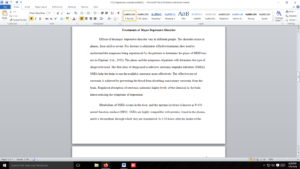Biological basis of the disorder
Paper to include:
Introduction:
Evaluate the disorder in terms of symptomatic and behavioral presentation. Include the time, course, and progression of the disorder. Evaluate and explain special features of the disease epidemiology including risk factors for development of the disorder, lifespan and reproductive factors increasing risk of developing the disorder, and any genetic, environmental, or behavioral factors that increase risk.
Theory:
Evaluate the predominant theory or theories regarding the biological basis of the disorder. Explain the disorder in terms of pertinent neurotransmitter and receptor theories and use your references to provide an evidence base for these theories. Analyze neurotransmitter system(s) involved in the pathology of the disorder, including a description of: 1) the involved neurotransmitter(s) and receptor(s), 2) regions of the nervous system (brain, spinal cord, or peripheral nervous system) involved with any pathological anatomical changes, and 3) abnormalities of neural circuits and pathways. Include an explanation of how receptor agonists or antagonists would theoretically treat the disorder to reverse the pathology and restore normal function, or why they would be expected to improve symptoms.
Treatment:
Evaluate drug therapies for treating the disorder based on the current understanding of the biological basis of the disorder. Include a description of the behavioral symptoms and physical signs of the disorder, and identify the drug class(es) used in pharmacological therapy with a discussion of the mechanism of action of the drug class(es). Explain why the pharmacodynamics of the drug class(es) would affect the pathology of the disorder to restore function and/or improve symptoms. Include a discussion of the drug pharmacokinetics for each drug class. Provide examples of available marketed drugs within each class. Describe any drug side effects and/or adverse effects of the drug treatment and their biological basis, including issues related to contraindications, interactions, drug metabolism, and elimination. In addition, explain risks, benefits, and ethical implications for high-risk and exceptional treatment conditions.
Conclusion:
Summarize theories of neuropsychological disorders as they relate to principles of drug action for that selected disorder. Provide a synopsis of the evidence base that supports or disproves current theories regarding the pathology of the disorder, advantages and disadvantages of current drug treatment(s). Lastly, evaluate any controversies regarding ethical and/or risk-benefit perspectives associated with the current treatment(s). Describe possible areas for future research.
APA Style 7 edition.
At least 6 Reference
it could be either Depression, or major depressive disorder (MDD).
Answer preview
Effects of the major depressive disorder vary in different people. The disorder occurs in phases, from mild to severe. For doctors to administer effective treatment, they need to understand the symptoms being experienced by the patients to determine the phase of MDD they are in (Cipriani et al., 2018). The phase and the symptoms of patients will determine the type of drugs to be used. The first class of drugs used is selective serotonin reuptake inhibitors (SSRIs). SSRIs help the brain to use the available serotonin more effectively. The effective use of serotonin is achieved by preventing the blood from absorbing unnecessary serotonin from the brain. Regulated absorption of serotonin maintains higher levels of the chemical in the brain hence reducing the symptoms of depression.
[1149 Words]

Biological basis of the disorder

